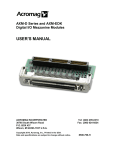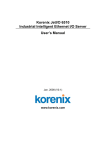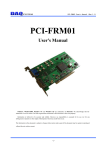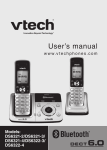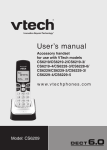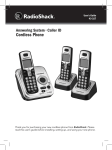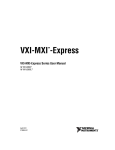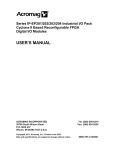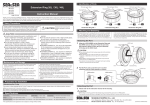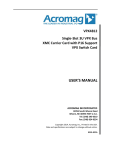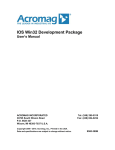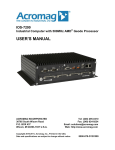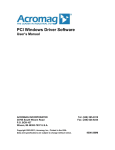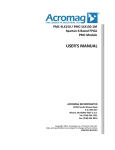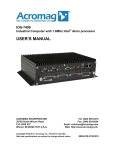Download AXM-D Series and AXM
Transcript
AXM-D Series and AXM-EDK Digital I/O Mezzanine Modules USER’S MANUAL ACROMAG INCORPORATED 30765 South Wixom Road P.O. BOX 437 Wixom, MI 48393-7037 U.S.A. Copyright 2010, Acromag, Inc., Printed in the USA. Data and specifications are subject to change without notice. Tel: (248) 295-0310 Fax: (248) 624-9234 8500-796-C10H012 2 AXM-D Series and AXM-EDK User’s Manual Digital I/O Mezzanine Board __________________________________________________________________ TABLE OF CONTENTS IMPORTANT SAFETY CONSIDERATIONS You must consider the possible negative effects of power, wiring, component, sensor, or software failure in the design of any type of control or monitoring system. This is very important where property loss or human life is involved. It is important that you perform satisfactory overall system design and it is agreed between you and Acromag, that this is your responsibility. 1.0 General Information The information of this manual may change without notice. Acromag makes no warranty of any kind with regard to this material, including, but not limited to, the implied warranties of merchantability and fitness for a particular purpose. Further, Acromag assumes no responsibility for any errors that may appear in this manual and makes no commitment to update, or keep current, the information contained in this manual. No part of this manual may be copied or reproduced in any form without the prior written consent of Acromag, Inc. KEY FEATURES…………...…………. ……………. . SIGNAL INTERFACE PRODUCTS..……………….. ENGINEERING DESIGN KIT...................................... BOARD CONTROL SOFTWARE............................... 4 5 5 5 2.0 PREPARATION FOR USE UNPACKING AND INSPECTION...…………………... CARD CAGE CONSIDERATIONS.........…………….. BOARD CONFIGURATION..........................………... Default Hardware Configuration.……………… Front Panel I/O...………………………………….. Non-Isolation Considerations........................... 6 6 6 6 6 12 3.0 PROGRAMMING INFORMATION MEMORY MAP..............................................………... Board Status and Reset Register..... Differential I/O Registers...........…….………… Digital Input/Output Registers..…………. Differential Interrupt Registers......................... 12 13 14 15 16 4.0 THEORY OF OPERATION DIFFERENTIAL INPUT/OUTPUT LOGIC..………..… DIGITAL INPUT/OUTPUT LOGIC........…............…... LVDS INPUT/OUTPUT LOGIC.................................. LVTTL DIRECT INTERFACE...................................... JTAG INTERFACE...................................................... INTERRUPT LOGIC.................................................... PMC BASE BOARD CONNECTION...…………......... 18 18 19 19 19 19 20 5.0 SERVICE AND REPAIR SERVICE AND REPAIR ASSITANCE...……………... PRELIMINARY SERVICE PROCEDURE...………….. WHERE TO GET HELP………………………………… 21 21 21 __________________________________________________________________________ Acromag, Inc. Tel:248-295-0310 Fax:248-624-9234 Email:[email protected] http://www.acromag.com AXM-D Series and AXM-EDK User’s Manual Digital I/O Mezzanine Board ___________________________________________________________________ 6.0 SPECIFICATIONS PHYSICAL.................................................................. ENVIRONMENTAL....…….…………………………….. DIFFERENTIAL INPUT/OUTPUT.....................……... DIGITAL INPUT/OUTPUT.....................…............…... LVDS INPUT/OUTPUT................................................ LVTTL INPUT/OUTPUT.............................................. 22 22 23 24 24 25 3 TABLE OF CONTENTS APPENDIX CABLE: MODEL 5028-432......................................... TERMINATION PANEL: MODEL 5025-288..……….. 26 26 DRAWINGS 4502-051A AXM-D02 BLOCK DIAGRAM................. 4502-051B AXM-D03 BLOCK DIAGRAM................. 4502-051C AXM-D04 BLOCK DIAGRAM................. 4502-056 AXM-EDK I/O LOCATION DRAWING....... 4502-055 AXM MECHANICAL ASSEMBLY............. 4501-919 CABLE 5028-432 (SHIELDED)................. 4501-920 TERMINATION PANEL 5025-288............. 27 27 28 28 29 29 30 Trademarks are the property of their respective owners. ________________________________________________________________________ Acromag, Inc. Tel:248-295-0310 Fax:248-624-9234 Email:[email protected] http://www.acromag.com 4 AXM-D Series and AXM-EDK User’s Manual Digital I/O Mezzanine Board __________________________________________________________________ 1.0 GENERAL INFORMATION The AXM-D series of daughter boards offer numerous digital options for Front I/O to Acromag’s line of re-configurable PMC modules. The AXM-D03 provides 22 differential & 16 CMOS input/output channels on the Front I/O for compatible Acromag PMC modules. The data direction, input/output, for each channel can be independently controlled. Eight change-of-state interrupt channels are provided on the least significant eight differential channels. The AXM-EDK board (sold with the PMC base boards’ Engineering Design Kit) provides the standard Xilinx JTAG header as well as direct connections to the Xilinx FPGA. These general purpose LVTTL (Low Voltage TTL) I/O points allow the user to emulate AXM-D modules while using ChipScope®. Table 1.1: AXM-D Series and AXM-EDK Models Front I/O Type Front I/O Connector OPERATING TEMPERATURE RANGE 68 SCSI -40°C to +85°C 68 SCSI -40°C to +85°C AXM-D04 30 Differential 22 Differential & 16 CMOS 30 LVDS 68 SCSI -40°C to +85°C AXM-EDK JTAG & LVTTL Xilinx Std JTAG & 34-Pin 0.1” Header -40°C to +85°C MODEL AXM-D02 AXM-D03 KEY FEATURES • Multifunction Modules – Various modules allows users to select the Front I/O required for their application. • Differential Input/Output Channels – Differential RS485/RS422 can be configured for input or output with independent direction control. • Digital Input/Output Channels – Interface with 5V compliant input/output CMOS channels which can be configured as input or output with independent direction control. • LVDS Input/Output Channels – Low voltage differential signaling can be configured for input or output with independent direction control. • Xilinx JTAG Interface – The EDK board provides the standard Xilinx JTAG interface to allow direct programming of the FPGA and an interface with ChipScope®. • Programmable Change of State/Level Interrupts – Example code provides interrupts that are software programmable for any bit ChangeOf-State or level on 8 channels. • Example Design – The example VHDL design, provided in the base board EDK, includes control of all I/O, and eight Change-Of-State interrupts. __________________________________________________________________________ Acromag, Inc. Tel:248-295-0310 Fax:248-624-9234 Email:[email protected] http://www.acromag.com AXM-D Series and AXM-EDK User’s Manual Digital I/O Mezzanine Board ___________________________________________________________________ The AXM-D models’ I/O is accessed via a 68 pin SCSI front panel connector. 5 SIGNAL INTERFACE PRODUCTS Cables and a termination panel are available to interface with these boards. Cable: Model 5028-432: A 2-meter, round 68 conductor shielded cable with a male SCSI-3 connector at both ends and 34 twisted pairs. This cable is used for connecting the board to Model 5025-288 termination panels. For optimum performance, use the shortest possible length of shielded cable. See the Appendix for further information on these products. Termination Panel: Model 5025-288: DIN-rail mountable panel provides 68 screw terminals for universal field I/O termination. Connects to Acromag board, via SCSI-3 to twisted pair cable described above. Acromag does not provide an engineering design kit specifically for the AXM-D modules. However, an example design for each module is included in the Engineering Design Kit of the PMC base board. Furthermore, the AXM-EDK is included with the Engineering Design Kit of the PMC base board to allow for programming via the JTAG interface. Refer to the PMC base board’s manual for further information on the available Engineering Design Kit. Acromag does not provide board control software specifically for the AXM-EDK and AXM-D series boards. However, the AXM-EDK and each AXM-D module can be accessed via the control software for the base PMC module. These products (sold separately) facilitate the product interface in the following operating systems: Windows DLL, VxWorks, and QNX. Refer to the PMC base board’s manual for further information. ENGINEERING DESIGN KIT BOARD CONTROL SOFTWARE ________________________________________________________________________ Acromag, Inc. Tel:248-295-0310 Fax:248-624-9234 Email:[email protected] http://www.acromag.com 6 AXM-D Series and AXM-EDK User’s Manual Digital I/O Mezzanine Board __________________________________________________________________ 2.0 PREPARATION FOR USE UNPACKING AND INSPECTION Upon receipt of this product, inspect the shipping carton for evidence of mishandling during transit. If the shipping carton is badly damaged or water stained, request that the carrier's agent be present when the carton is opened. If the carrier's agent is absent when the carton is opened and the contents of the carton are damaged, keep the carton and packing material for the agent's inspection. For repairs to a product damaged in shipment, refer to the Acromag Service Policy to obtain return instructions. It is suggested that salvageable shipping cartons and packing material be saved for future use in the event the product must be shipped. WARNING: This board utilizes static sensitive components and should only be handled at a static-safe workstation. This board is physically protected with packing material and electrically protected with an anti-static bag during shipment. However, it is recommended that the board be visually inspected for evidence of mishandling prior to applying power. CARD CAGE CONSIDERATIONS Refer to the specifications for loading and power requirements. Be sure that the system power supplies are able to accommodate the power requirements of the system boards, plus the installed Acromag board, within the voltage tolerances specified. IMPORTANT: Adequate air circulation must be provided to prevent a temperature rise above the maximum operating temperature. Adequate air circulation must be provided to prevent a temperature rise above the maximum operating temperature and to prolong the life of the electronics. If the installation is in an industrial environment and the board is exposed to environmental air, careful consideration should be given to airfiltering. BOARD CONFIGURATION Remove power from the system before installing board, cables, termination panels, and field wiring. Default Hardware Configuration The AXM-EDK and AXM-D Series boards cannot stand-alone and must be mated with a compatible Acromag PMC module. The default configuration of the control register bits at power-up is described in section 3. Front Panel Field I/O Connector The front panel connector provides the field I/O interface connections. For the AXM-D series, it is a SCSI-3 68-pin female connector (AMP 5787394-7 or equivalent) employing latch blocks and 30 micron gold in the mating area (per MIL-G-45204, Type II, Grade C). Connects to Acromag termination panel 5025-288 from the front panel via round shielded cable (Model 5028-432). __________________________________________________________________________ Acromag, Inc. Tel:248-295-0310 Fax:248-624-9234 Email:[email protected] http://www.acromag.com AXM-D Series and AXM-EDK User’s Manual Digital I/O Mezzanine Board ___________________________________________________________________ 7 The AXM-EDK board has two front I/O connectors. The first is a double row 14-pin 2mm header (male) for JTAG programming. This is the standard Xilinx JTAG Header. The other I/O interface is a double row 34-pin 0.1” header (male). A standard floppy drive cable can be used to connect to the interface. Note neither cables are available from Acromag. The AXM-D02 module has 30 differential I/O channels. The data direction of the differential channels numbered 0 to 29 are independently controlled via the Differential Direction Register. The pinout is shown in Table 2.1. SCSI-3 68-Pin Female Connector Pin Description Pin Pin Description COMMON 1 COMMON Differential Ch0+ 2 Differential Ch0Differential Ch1+ 3 Differential Ch1Differential Ch2+ 4 Differential Ch2Differential Ch3+ 5 Differential Ch3Differential Ch4+ 6 Differential Ch4Differential Ch5+ 7 Differential Ch5Differential Ch6+ 8 Differential Ch6Differential Ch7+ 9 Differential Ch7Differential Ch8+ 10 Differential Ch8Differential Ch9+ 11 Differential Ch9COMMON 12 COMMON Differential Ch10+ 13 Differential Ch10Differential Ch11+ 14 Differential Ch11Differential Ch12+ 15 Differential Ch12Differential Ch13+ 16 Differential Ch13Differential Ch14+ 17 Differential Ch14Differential Ch15+ 18 Differential Ch15Differential Ch16+ 19 Differential Ch16Differential Ch17+ 20 Differential Ch17Differential Ch18+ 21 Differential Ch18Differential Ch19+ 22 Differential Ch19COMMON 23 COMMON Differential Ch20+ 24 Differential Ch20Differential Ch21+ 25 Differential Ch21Differential Ch22+ 26 Differential Ch22Differential Ch23+ 27 Differential Ch23Differential Ch24+ 28 Differential Ch24Differential Ch25+ 29 Differential Ch25Differential Ch26+ 30 Differential Ch26Differential Ch27+ 31 Differential Ch27Differential Ch28+ 32 Differential Ch28Differential Ch29+ 33 Differential Ch29COMMON 34 COMMON Pin 35 36 37 38 39 40 41 42 43 44 45 46 47 48 49 50 51 52 53 54 55 56 57 58 59 60 61 62 63 64 65 66 67 68 AXM-D02 Front I/O Table 2.1: AXM-D02 Board Field I/O Pin Connections ________________________________________________________________________ Acromag, Inc. Tel:248-295-0310 Fax:248-624-9234 Email:[email protected] http://www.acromag.com 8 AXM-D Series and AXM-EDK User’s Manual Digital I/O Mezzanine Board __________________________________________________________________ AXM-D03 Front I/O Table 2.2: AXM-D03 Board Field I/O Pin Connections DIFFERENTIAL CHANNELS ARE NUMBERED 8 to 29. THERE ARE NO DIFFERENTIAL CHANNELS 0 to 7 ON THIS MODULE. The AXM-D03 module has 22 differential I/O channels and 16 digital (CMOS) channels. The data direction of the differential channels numbered 8 to 29 and digital channels numbered 0 to 15 are independently controlled via the Differential and Digital Direction Registers. The pinout is shown in Table 2.2. SCSI-3 68-Pin Female Connector Pin Description Pin Pin Description COMMON 1 COMMON Digital Channel 0 2 Digital Channel 8 Digital Channel 1 3 Digital Channel 9 Digital Channel 2 4 Digital Channel 10 Digital Channel 3 5 Digital Channel 11 Digital Channel 4 6 Digital Channel 12 Digital Channel 5 7 Digital Channel 13 Digital Channel 6 8 Digital Channel 14 Digital Channel 7 9 Digital Channel 15 Differential Ch8+ 10 Differential Ch8Differential Ch9+ 11 Differential Ch9COMMON 12 COMMON Differential Ch10+ 13 Differential Ch10Differential Ch11+ 14 Differential Ch11Differential Ch12+ 15 Differential Ch12Differential Ch13+ 16 Differential Ch13Differential Ch14+ 17 Differential Ch14Differential Ch15+ 18 Differential Ch15Differential Ch16+ 19 Differential Ch16Differential Ch17+ 20 Differential Ch17Differential Ch18+ 21 Differential Ch18Differential Ch19+ 22 Differential Ch19COMMON 23 COMMON Differential Ch20+ 24 Differential Ch20Differential Ch21+ 25 Differential Ch21Differential Ch22+ 26 Differential Ch22Differential Ch23+ 27 Differential Ch23Differential Ch24+ 28 Differential Ch24Differential Ch25+ 29 Differential Ch25Differential Ch26+ 30 Differential Ch26Differential Ch27+ 31 Differential Ch27Differential Ch28+ 32 Differential Ch28Differential Ch29+ 33 Differential Ch29COMMON 34 COMMON Pin 35 36 37 38 39 40 41 42 43 44 45 46 47 48 49 50 51 52 53 54 55 56 57 58 59 60 61 62 63 64 65 66 67 68 __________________________________________________________________________ Acromag, Inc. Tel:248-295-0310 Fax:248-624-9234 Email:[email protected] http://www.acromag.com AXM-D Series and AXM-EDK User’s Manual Digital I/O Mezzanine Board ___________________________________________________________________ The AXM-D04 module has 30 Low Voltage Differential Signaling (LVDS) channels. The data direction of the differential channels numbered 0 to 29 are independently controlled via the Differential Direction Registers. The pinout is shown in Table 2.3. SCSI-3 68-Pin Female Connector Pin Description Pin Pin Description COMMON 1 COMMON LVDS Ch0+ 2 LVDS Ch0LVDS Ch1+ 3 LVDS Ch1LVDS Ch2+ 4 LVDS Ch2LVDS Ch3+ 5 LVDS Ch3LVDS Ch4+ 6 LVDS Ch4LVDS Ch5+ 7 LVDS Ch5LVDS Ch6+ 8 LVDS Ch6LVDS Ch7+ 9 LVDS Ch7LVDS Ch8+ 10 LVDS Ch8LVDS Ch9+ 11 LVDS Ch9COMMON 12 COMMON LVDS Ch10+ 13 LVDS Ch10LVDS Ch11+ 14 LVDS Ch11LVDS Ch12+ 15 LVDS Ch12LVDS Ch13+ 16 LVDS Ch13LVDS Ch14+ 17 LVDS Ch14LVDS Ch15+ 18 LVDS Ch15LVDS Ch16+ 19 LVDS Ch16LVDS Ch17+ 20 LVDS Ch17LVDS Ch18+ 21 LVDS Ch18LVDS Ch19+ 22 LVDS Ch19COMMON 23 COMMON LVDS Ch20+ 24 LVDS Ch20LVDS Ch21+ 25 LVDS Ch21LVDS Ch22+ 26 LVDS Ch22LVDS Ch23+ 27 LVDS Ch23LVDS Ch24+ 28 LVDS Ch24LVDS Ch25+ 29 LVDS Ch25LVDS Ch26+ 30 LVDS Ch26LVDS Ch27+ 31 LVDS Ch27LVDS Ch28+ 32 LVDS Ch28LVDS Ch29+ 33 LVDS Ch29COMMON 34 COMMON 9 AXM-D04 Front I/O Table 2.3: AXM-D04 Board Field I/O Pin Connections Pin 35 36 37 38 39 40 41 42 43 44 45 46 47 48 49 50 51 52 53 54 55 56 57 58 59 60 61 62 63 64 65 66 67 68 ________________________________________________________________________ Acromag, Inc. Tel:248-295-0310 Fax:248-624-9234 Email:[email protected] http://www.acromag.com 10 AXM-D Series and AXM-EDK User’s Manual Digital I/O Mezzanine Board __________________________________________________________________ AXM-EDK Front I/O The AXM-EDK has a standard 34 pin double row 0.1” header for front I/O. The I/O are LVTTL compatible. These pin connections can emulate the 30 differential channels on the AXM-D02 and AXM-D04 models and the 22 differential channels on the AXM-D03 model using LVTTL signaling. Refer to the Differential I/O Register section for further information. Front I/O connections are listed in Table 2.4a. The AXM-EDK front I/O also includes the standard Xilinx 14-pin 2mm JTAG header. This header can be used to directly program the FPGA or to interface with the FPGA debug software ChipScope®. The pin connections are shown in table 2.4b. In addition, the AXM-EDK contains 16 auxiliary pins that are routed to two 8 pin SIP patterns on the board. Note that these are not front panel I/O connections. Due to height restrictions SIP sockets are not installed. This allows for full end user customization. These pins correspond to the 16 channels of Digital I/O on the AXM-D03 module. Refer to the Digital I/O Register section for further information. The connections are listed in table 2.4c. Refer to drawing 4502-056, located at the end of this manual, for I/O pin locations on the AXM-EDK. Table 2.4a: AXM-EDK Board Field I/O Pin Connections Table 2.4b: AXM-EDK Board Field JTAG Pin Connections 34-Pin Double Row 0.1” I/O Header Pin Description Pin Pin Description COMMON 1 COMMON LVTTL Channel 0 3 LVTTL Channel 1 LVTTL Channel 2 5 LVTTL Channel 3 LVTTL Channel 4 7 LVTTL Channel 5 LVTTL Channel 6 9 LVTTL Channel 7 LVTTL Channel 8 11 LVTTL Channel 9 LVTTL Channel 10 13 LVTTL Channel 11 LVTTL Channel 12 15 LVTTL Channel 13 LVTTL Channel 14 17 LVTTL Channel 15 LVTTL Channel 16 19 LVTTL Channel 17 LVTTL Channel 18 21 LVTTL Channel 19 LVTTL Channel 20 23 LVTTL Channel 21 LVTTL Channel 22 25 LVTTL Channel 23 LVTTL Channel 24 27 LVTTL Channel 25 LVTTL Channel 26 29 LVTTL Channel 27 LVTTL Channel 28 31 LVTTL Channel 29 COMMON 33 COMMON Pin 2 4 6 8 10 12 14 16 18 20 22 24 26 28 30 32 34 14-Pin 2mm Double Row JTAG Header Pin Description Pin Pin Description COMMON 1 +3.3V COMMON 3 TMS COMMON 5 TCK COMMON 7 TDO COMMON 9 TDI 11 Not Connected COMMON 13 Not Connected COMMON Pin 2 4 6 8 10 12 14 __________________________________________________________________________ Acromag, Inc. Tel:248-295-0310 Fax:248-624-9234 Email:[email protected] http://www.acromag.com AXM-D Series and AXM-EDK User’s Manual Digital I/O Mezzanine Board ___________________________________________________________________ 11 AXM-EDK Front I/O Auxiliary (LVTTL) I/O Pin Connections (SIP) SIP 1 (S1) SIP 2 (S2) Pin Description Pin Pin Description AUX Channel 0 1 AUX Channel 8 AUX Channel 1 2 AUX Channel 9 AUX Channel 2 3 AUX Channel 10 AUX Channel 3 4 AUX Channel 11 AUX Channel 4 5 AUX Channel 12 6 AUX Channel 13 AUX Channel 5 7 AUX Channel 14 AUX Channel 6 8 AUX Channel 15 AUX Channel 7 Table 2.4c: AXM-EDK Auxiliary I/O Pin Connections Pin 1 2 3 4 5 6 7 8 The board is non-isolated, since there is electrical continuity between the logic and field I/O grounds. As such, the field I/O connections are not isolated from the system. Care should be taken in designing installations without isolation to avoid noise pickup and ground loops caused by multiple ground connections. Non-Isolation Considerations ________________________________________________________________________ Acromag, Inc. Tel:248-295-0310 Fax:248-624-9234 Email:[email protected] http://www.acromag.com 12 AXM-D Series and AXM-EDK User’s Manual Digital I/O Mezzanine Board __________________________________________________________________ 3.0 PROGRAMMING INFORMATION This Section provides the specific information necessary to program and operate the boards. These models are daughter cards intended only for use on specific Acromag PMC modules. As such only a small portion of I/O memory space is currently reserved for operation of the daughter card. The remaining memory space is defined in the base boards User’s Manual. AXM-EDK & AXM-D GENERIC MEMORY MAP Table 3.2: Memory Map 1. This address space is not defined for this module. This space may be used on the base PMC Module. Refer to the base PMC module User’s Manual for further information 2. These registers have bits that are reserved for the base PMC module. See the register definition later in this manual for further details. 3. The bits used in these registers varies for each model. Refer to the register descriptions in the following pages for specific module mapping. 4. The board will return 0 for all addresses that are "Not Used". The generic memory space address map for the board is shown in Table 3.2. The actual bit mapping in the individual registers varies by the mezzanine module and are detailed in the register descriptions later in this manual. Note that the base address from the base PMC module in memory space must be added to the addresses shown to properly access the board registers. Register accesses as 32, 16, and 8-bits in memory space are permitted. Base Addr+ 0003 ↓ 7FFF D31 D16 D15 D00 Base Addr+ Reserved for base PMC Module1 0000 ↓ 7FFC 8003 Board Status Register and Software Reset2 8000 8007 29-0 Differential & EDK I/O Register3 8004 800B Direction Register Differential & EDK Channels 29-03 8008 800F 15-0 Digital I/O Register3 800C 8013 8017 801B 801F Direction Register Digital Channels 15-03 Interrupt Enable Not Used4 Differential Ch. 15-8 Interrupt Type Not Used4 Differential Ch. 15-8 Interrupt Polarity Not Used4 Differential Ch. 15-8 8010 8014 8018 801C 8023 Not Used4 8020 8027 Not Used4 8024 802B Not Used4 8028 802F ↓ 1FFFFF Reserved for base PMC Module1 802C ↓ 1FFFFC __________________________________________________________________________ Acromag, Inc. Tel:248-295-0310 Fax:248-624-9234 Email:[email protected] http://www.acromag.com AXM-D Series and AXM-EDK User’s Manual Digital I/O Mezzanine Board ___________________________________________________________________ 13 This memory map reflects byte accesses using the “Little Endian” byte ordering format. Little Endian uses even-byte addresses to store the loworder byte. The Intel x86 family of microprocessors uses “Little Endian” byte ordering. Big Endian is the convention used in the Motorola 68000 microprocessor family and is the VMEbus convention. In Big Endian, the lower-order byte is stored at odd-byte addresses. Board Status and Software Reset Register (Read/Write) – (Base Addr + 8000H) BOARD STATUS AND RESET REGISTER This read/write register is used the issue a software reset, view and clear pending interrupts, and to identify the attached AXM module. It may also provide other functions that are defined by the base board. Writing a “1” to bit 31 of this register will cause a software reset effecting both the PMC base board and all of the AXM series registers. Bits 15 to 13 are used for AXM identification code. Bits 0 to 7 or this register reflect the status of each of the Differential I/O channels 8 to 15. A Read of this bit reflects the interrupt pending status. Read of a “1” indicates that an interrupt is pending for the corresponding differential channel. Write of a logic “1” to this bit will release the corresponding differential channel’s pending interrupt. Writing “0” to a bit location has no effect, a pending interrupt will remain pending. BIT 0 1 2 3 4 5 6 7 12-8 FUNCTION Differential Channel 8 Interrupt Pending/Clear Differential Channel 9 Interrupt Pending/Clear Differential Channel 10 Interrupt Pending/Clear Differential Channel 11 Interrupt Pending/Clear Differential Channel 12 Interrupt Pending/Clear Differential Channel 13 Interrupt Pending/Clear Differential Channel 14 Interrupt Pending/Clear Differential Channel 15 Interrupt Pending/Clear Reserved for PMC base board3 1,2 AXM Identification bits (Read Only) 15-13 AXM-D “001” AXM-EDK “001” 30-16 Reserved for PMC base board3 31 Software Reset (Write Only) 1. Note that if no AXM module is attached the register will still read “001”. It is up to the end user to differentiate if no mezzanine module is attached. 2. All other 3 bit values are reserved for future use. 3. Bit function is defined by the base PMC Module. This register can be written with either 8-bit, 16-bit, or 32-bit data transfers. ________________________________________________________________________ Acromag, Inc. Tel:248-295-0310 Fax:248-624-9234 Email:[email protected] http://www.acromag.com 14 AXM-D Series and AXM-EDK User’s Manual Digital I/O Mezzanine Board __________________________________________________________________ DIFFERENTIAL INPUT/OUTPUT REGISTERS Differential & EDK Input/Output Registers (Read/Write) – (Base Addr + 8004H) AXM-D differential channels and the AXM-EDK LVTTL channels may be individually accessed via this register at the carrier base address +8004H. This includes all 30 differential channels on the AXM-D02, 22 differential channels on the AXM-D03, 30 LVDS channels on the AXM-D04, and 30 general purpose LVTTL channels on the AXM-EDK. Each channel is controlled by its corresponding data bit, as shown in the register mapping table below. Channel input signal levels are determined by reading this register. Likewise, channel output signal levels are set by writing to this register. Note that the data direction, input or output, must first be set via the Differential Direction register at base address plus 8008H. Model AXM-EDK AXM-D02 AXM-D03 AXM-D04 D31 D30 Not Used Not Used Not Used Not Used Differential I/O Register Mapping D29 D28 D27 D26 I/O 29 I/O 28 I/O 27 I/O 26 Diff 29 Diff 28 Diff 27 Diff 26 Diff 29 Diff 28 Diff 27 Diff 26 LVDS 29 LVDS 28 LVDS 27 LVDS 26 D25 I/O 25 Diff 25 Diff 25 LVDS 25 D24 I/O 24 Diff 24 Diff 24 LVDS 24 AXM-EDK AXM-D02 AXM-D03 AXM-D04 D23 I/O 23 Diff 23 Diff 23 LVDS 23 D22 I/O 22 Diff 22 Diff 22 LVDS 22 D21 I/O 21 Diff 21 Diff 21 LVDS 21 D20 I/O 20 Diff 20 Diff 20 LVDS 20 D19 I/O 19 Diff 19 Diff 19 LVDS 19 D18 I/O 18 Diff 18 Diff 18 LVDS 18 D17 I/O 17 Diff 17 Diff 17 LVDS 17 D16 I/O 16 Diff 16 Diff 16 LVDS 16 AXM-EDK AXM-D02 AXM-D03 AXM-D04 D15 I/O 15 Diff 15 Diff 15 LVDS 15 D14 I/O 14 Diff 14 Diff 14 LVDS 14 D13 I/O 13 Diff 13 Diff 13 LVDS 13 D12 I/O 12 Diff 12 Diff 12 LVDS 12 D11 I/O 11 Diff 11 Diff 11 LVDS 11 D10 I/O 10 Diff 10 Diff 10 LVDS 10 D9 I/O 9 Diff 9 Diff 9 LVDS 9 D8 I/O 8 Diff 8 Diff 8 LVDS 8 D7 I/O 7 Diff 7 D6 I/O 6 Diff 6 D1 I/O 1 Diff 1 D0 I/O 0 Diff 0 LVDS 7 LVDS 6 LVDS 1 LVDS 0 AXM-EDK AXM-D02 AXM-D03 AXM-D04 D5 D4 D3 D2 I/O 5 I/O 4 I/O 3 I/O 2 Diff 5 Diff 4 Diff 3 Diff 2 Diff Channels 0-7 are not used in this module. LVDS 5 LVDS 4 LVDS 3 LVDS 2 Channel read/write operations use 8-bit, 16-bit, or 32-bit data transfers with the lower ordered bits corresponding to the lower-numbered channels for the register of interest. All input/output channels are configured as inputs following a power-on or software reset. Data-bits 30 and 31 are not used and will return 0 when read. Data bits 0 through 7 in the AXM-D03 module will read back the last data values written to those bits. __________________________________________________________________________ Acromag, Inc. Tel:248-295-0310 Fax:248-624-9234 Email:[email protected] http://www.acromag.com AXM-D Series and AXM-EDK User’s Manual Digital I/O Mezzanine Board ___________________________________________________________________ Differential Direction Control Register (Read/Write) – (Base Addr + 8008H) 15 DIFFERENTIAL INPUT/OUTPUT REGISTERS The data direction (input or output) of the differential channels is selected via this register at the carrier base address +8008H. This includes the direction of all 30 differential channels on the AXM-D02, 22 differential channels on the AXM-D03, 30 LVDS channels on the AXM-D04, and 30 general purpose LVTTL channels on the AXM-EDK. The direction of each channel is controlled by its corresponding data bit. Data bit use varies depending on the module selected. The bit mapping corresponds to the Differential and EDK I/O Register. Independent channel direction control is provided for each differential channel. Setting a bit low configures the corresponding channel data direction for input. Setting the control bit high configures the corresponding channel data direction for output. The default power-up state of these registers is logic low. Thus, all channels are configured as inputs following system reset or power-up. Reading or writing to this register is possible via 32-bit, 16-bit or 8-bit data transfers. Data-bits 30 and 31 are not used and will return 0 when read. Data bits 0 through 7 in the AXM-D03 module will read back the last data values written to those bits. Digital Input/Output Registers (Read/Write) – (Base Addr + 800CH) Digital CMOS input/output channels may be individually accessed via this register at the carrier base address +800CH. This includes the sixteen CMOS Channels on the AXM-D03 and the sixteen auxiliary LVTTL I/O on the AXM-EDK module. Channel input signal levels are determined by reading this register. Likewise, channel output signal levels are set by writing to this register. The data bits are mapped according to the following table. Note that the data direction, input or output, must first be set via the Digital Direction register at base address plus 8010H. Model AXM-EDK AXM-D02 AXM-D03 AXM-D04 AXM-EDK AXM-D02 AXM-D03 AXM-D04 DIGITAL INPUT/OUTPUT REGISTERS Digital I/O Register Mapping D13 D12 D11 D10 AUX 13 AUX 12 AUX 11 AUX 10 Not Used DIG 13 DIG 12 DIG 11 DIG 10 Not Used D15 AUX 15 D14 AUX 14 DIG 15 DIG 14 D7 AUX 7 D6 AUX 6 D5 AUX 5 DIG 7 DIG 6 DIG 5 D4 D3 AUX 4 AUX 3 Not Used DIG 4 DIG 3 Not Used D9 AUX 9 D8 AUX 8 DIG 9 DIG 8 D2 AUX 2 D1 AUX 1 D0 AUX 0 DIG 2 DIG 1 DIG 0 ________________________________________________________________________ Acromag, Inc. Tel:248-295-0310 Fax:248-624-9234 Email:[email protected] http://www.acromag.com 16 AXM-D Series and AXM-EDK User’s Manual Digital I/O Mezzanine Board __________________________________________________________________ DIGITAL INPUT/OUTPUT REGISTERS Channel read/write operations use 8-bit, 16-bit, or 32-bit data transfers with the lower ordered bits corresponding to the lower-numbered channels for the register of interest. All input/output channels are configured as inputs following a power-on or software reset. Data-bits 16 through 31 are not used and will return 0 when read. Data bits 0 through 15 on the AXM-D02 and AXM-D04 modules are not used and will read back the last data value written to them. Digital Direction Control Register (Read/Write) – (Base Addr + 8010H) The data direction (input or output) of the digital channels is selected via this register at the carrier base address +8010H. This includes the sixteen CMOS Channels on the AXM-D03 and the sixteen auxiliary LVTTL I/O on the AXM-EDK module. The direction of each channel is controlled by its corresponding data bit. The register mapping is the same as the Digital I/O Register. Data-bits 16 through 31 are not used and will return 0 when read. Data bits 0 through 15 on the AXM-D02 and AXM-D04 modules are not used and will read back the last data value written to them. Independent channel direction control is provided for each digital channel. Setting a bit low configures the corresponding channel data direction for input. Setting the control bit high configures the corresponding channel data direction for output. The default power-up state of these registers is logic low. Thus, all channels are configured as inputs following system reset or power-up. Reading or writing to this register is possible via 32-bit, 16-bit or 8-bit data transfers. DIFFERENTIAL INTERRUPT REGISTERS Interrupt Enable Register (Read/Write) – (Base Addr + 8014H) The Interrupt Enable Register provides a map bit for each differential channel from 8 to 15. A “0” bit will prevent the corresponding input channel from generating an external interrupt. A “1” bit will allow the corresponding channel to generate an interrupt. The Interrupt Enable register at the base address + offset 8014H is used to control channels 8 through 15 via data bits 0 to 7. Bits 8 to 15 are not used and will always read as “0”. All channel interrupts are disabled (set to “0”) following a power-on or software reset. Reading or writing to this register is possible via 32-bit, 16bit or 8-bit data transfers. Additional steps may be required to enable interrupts. Refer to the PMC base module’s User’s Manual for further information. Model AXM-EDK AXM-D02 AXM-D03 AXM-D04 D7 I/O 15 Diff 15 Diff 15 LVDS 15 D6 I/O 14 Diff 14 Diff 14 LVDS 14 Interrupt Register Mapping D5 D4 D3 D2 I/O 13 I/O 12 I/O 11 I/O 10 Diff 13 Diff 12 Diff 11 Diff 10 Diff 13 Diff 12 Diff 11 Diff 10 LVDS 13 LVDS 12 LVDS 11 LVDS 10 D1 I/O 9 Diff 9 Diff 9 LVDS 9 D0 I/O 8 Diff 8 Diff 8 LVDS 8 __________________________________________________________________________ Acromag, Inc. Tel:248-295-0310 Fax:248-624-9234 Email:[email protected] http://www.acromag.com AXM-D Series and AXM-EDK User’s Manual Digital I/O Mezzanine Board ___________________________________________________________________ Interrupt Type (COS or H/L) Configuration Register (Read/Write) - (Base Addr + 8018) 17 DIFFERENTIAL INTERRUPT REGISTERS The Interrupt Type Configuration Register determines the type of input channel transition that will generate an interrupt for each of the eight possible interrupting channels. A “0” bit selects interrupt on level. An interrupt will be generated when the input channel level specified by the Interrupt Polarity Register occurs (i.e. Low or High level transition interrupt). A “1” bit means the interrupt will occur when a Change-Of-State (COS) occurs at the corresponding input channel (i.e. any state transition, low to high or high to low). The Interrupt Type Configuration register at base address +8018H is used to control channels 8 through 15 as mapped in the Interrupt Enable Register. For example, channel 8 is controlled via data bit-0. Bits 8 to 15 are not used and will always read as “0”. All bits are set to “0” following a reset which means that, if enabled, the inputs will cause interrupts for the levels specified by the Interrupt Polarity Register. Channel read or write operations use 8-bit, 16-bit, or 32-bit data transfers. Note that no interrupts will occur unless they are enabled by the Interrupt Enable Register. Interrupt Polarity Register (Read/Write) – (Base Addr + 801C) The Interrupt Polarity Register determines the level that will cause a channel interrupt to occur for each of the channels enabled for level interrupts. A “0” bit specifies that an interrupt will occur when the corresponding input channel is low (i.e. a “0” in the differential input channel data register). A “1” bit means that an interrupt will occur when the input channel is high (i.e. a “1” in the differential input channel data register). Note that no interrupts will occur unless they are enabled by the Interrupt Enable Register. Further, the Interrupt Polarity Register will have no effect if the Change-of-State (COS) interrupt type is configured by the Interrupt Type Configuration Register. The Interrupt Polarity register at the base address + offset 801CH is used to control differential channels 8 through 15 as mapped in the Interrupt Enable Register. For example, channel 8 is controlled via data bit-0. Bits 8 to 15 are not used and will always read as “0”. All bits are set to “0” following a reset, which means that the inputs will cause interrupts when they are logic low (provided they are enabled for interrupt on level). ________________________________________________________________________ Acromag, Inc. Tel:248-295-0310 Fax:248-624-9234 Email:[email protected] http://www.acromag.com 18 AXM-D Series and AXM-EDK User’s Manual Digital I/O Mezzanine Board __________________________________________________________________ 4.0 THEORY OF OPERATION This section contains information regarding the hardware of the board. A description of the basic functionality of the circuitry used on the board is also provided. Note that each section does not necessarily apply to every model. Refer to table below to determine the appropriate sections. MODEL I/O Type Interrupts JTAG Support AXM-D02 8 Channels No 8 Channels No AXM-D04 30 Differential 22 Differential & 16 CMOS Digital 30 LVDS 8 Channels No AXM-EDK 30 LVTTL 8 Channels Yes AXM-D03 DIFFERENTIAL INPUT/OUTPUT LOGIC Differential I/O are provided on the AXM-D02 and AXM-D03 models through the Field I/O Connector (refer to Table 2.1 and 2.2). Field I/O points are NON-ISOLATED. This means that the field return and logic common have a direct electrical connection to each other. As such, care must be taken to avoid ground loops. Ignoring this effect may cause operation errors, and with extreme abuse, possible circuit damage. Differential channels to the FPGA are buffered using EIA RS485/RS422 line transceivers. The transceivers are considered failsafe as a open or short circuit on the I/O will not damage the board. Field input lines are not terminated. External 120 Ohm resistors are recommended on all receivers. Signals received are converted from the required EIA RS485/RS422 voltages to the LVTTL levels required by the FPGA. Likewise, LVTTL signals are converted to the EIA RS485/RS422 voltages for data output transmission. The direction control of the differential channels is independently controlled. CMOS DIGITAL INPUT/OUTPUT LOGIC Digital field I/O are provided on the AXM-D03 model through the Field I/O Connector (refer to Table 2.2). Field I/O points are NON-ISOLATED. This means that the field return and logic common have a direct electrical connection to each other. As such, care must be taken to avoid ground loops. Ignoring this effect may cause operation errors, and with extreme abuse, possible circuit damage. Digital input/output signals to the FPGA are buffered using a dual voltage digital transceiver. Signals received are converted from 5V CMOS to LVTTL as required by the FPGA. Likewise LVTTL signals are converted to 5V CMOS voltages for data output transmission. The direction control of the digital channels is independently controlled. Each field line has a 10K pullup resistor to +5V. Output operation is considered ‘Fail-safe’. That is, the Digital Input/Output signals are always configured as inputs following a power-up or software reset. This is done for safety reasons to ensure reliable control under all conditions. __________________________________________________________________________ Acromag, Inc. Tel:248-295-0310 Fax:248-624-9234 Email:[email protected] http://www.acromag.com AXM-D Series and AXM-EDK User’s Manual Digital I/O Mezzanine Board ___________________________________________________________________ LVDS I/O on the AXM-D04 are provided through the Field I/O Connector (refer to Table 2.3). Field I/O points are NON-ISOLATED. This means that the field return and logic common have a direct electrical connection to each other. As such, care must be taken to avoid ground loops. Ignoring this effect may cause operation errors, and with extreme abuse, possible circuit damage. 19 LVDS INPUT/OUTPUT LOGIC LVDS channels (0-31) to the FPGA are buffered using multidrop LVDS line drivers and receivers. The drivers and receivers are standard LVDS signaling characteristics (TIA/EIA-644) with double the current for multipoint applications. Field inputs to these receivers include a 100 ohm termination resistor. Signals received are converted from the LVDS voltages to the LVTTL levels required by the FPGA. Likewise, LVTTL signals are converted to the TIA/EIA-644 LVDS voltages for data output transmission. The direction control of the LVDS channels is independently controlled. The AXM-EDK has a total of 46 (30 General Purpose and 16 auxiliary) channels of LVTTL. These I/O provide a direct connection through the mezzanine connector to the adjoining FPGA. There are no intermediate buffers on the I/O. As such care must be taken to limit overshoot (to 3.6V) and to prevent ESD, or the FPGA on the PMC base board may be damaged. LVTTL DIRECT INTERFACE The I/O on the AXM-EDK are mapped to simulate the various types of I/O that can be found on the AXM-D series modules. Therefore the same registers can be used to simulate the Field I/O on the AXM-EDK. The 30 general purpose I/O map to the 30 differential I/O on the AXM-D02, the 22 differential I/O on the AXM-D03, and 30 LVDS I/O on the AXM-D04. The 16 auxiliary I/O map to the 16 differential signal on the AXM-D03. Note that regardless of which AXM-D module is being emulated, the AXM-EDK I/O are all 3.3V LVTTL. The AXM-EDK model has a front field I/O Xilinx JTAG header. It readily connects to any compatible Xilinx programming system such as the MULTIPro Tool® or Parallel Cable programming system. In general, the JTAG interface pins connect only to the Xilinx FPGA. See the PMC base board for further information. The JTAG interface is powered by 3.3V. JTAG INTERFACE Eight Channels in each model can be configured to generate interrupts for Change-Of-State (COS) and input level (polarity) match conditions. The interrupt is released via a write to the corresponding bit of the Interrupt Status/Clear register. The channels enabled for interrupt in the example design are Differential Channels 8 to 15 on the AXM-D02 and AXM-D03, LVDS Channels 8 to 15 on the AXM-D04, and LVTTL Channels 8-15 on the AXM-EDK. INTERRUPT LOGIC ________________________________________________________________________ Acromag, Inc. Tel:248-295-0310 Fax:248-624-9234 Email:[email protected] http://www.acromag.com 20 AXM-D Series and AXM-EDK User’s Manual Digital I/O Mezzanine Board __________________________________________________________________ PMC BASE BOARD CONNECTION The AXM-EDK and AXM-D series of extension I/O modules are attached to the PMC base board via a high speed 150 pin header. The connector provides power to the extension board and multiple logic connections to the base board. Note that any PMC base board with a re-configurable FPGA will require the pin definitions provided in the EDK to properly operate the AXM-EDK and AXM-D series boards. __________________________________________________________________________ Acromag, Inc. Tel:248-295-0310 Fax:248-624-9234 Email:[email protected] http://www.acromag.com AXM-D Series and AXM-EDK User’s Manual Digital I/O Mezzanine Board ___________________________________________________________________ Surface-Mounted Technology (SMT) boards are generally difficult to repair. It is highly recommended that a non-functioning board be returned to Acromag for repair. The board can be easily damaged unless special SMT repair and service tools are used. Further, Acromag has automated test equipment that thoroughly checks the performance of each board. When a board is first produced and when any repair is made, it is tested, placed in a burn-in room at elevated temperature, and retested before shipment. Please refer to Acromag's Service Policy Bulletin or contact Acromag for complete details on how to obtain parts and repair. 21 5.0 SERVICE AND REPAIR SERVICE AND REPAIR ASSISTANCE Before beginning repair, be sure that all of the procedures in Section 2, Preparation For Use, have been followed. Also, refer to the documentation of your carrier/CPU board to verify that it is correctly configured. Replacement of the board with one that is known to work correctly is a good technique to isolate a faulty board. PRELIMINARY SERVICE PROCEDURE If you continue to have problems, your next step should be to visit the Acromag worldwide web site at http://www.acromag.com. Our web site contains the most up-to-date product and software information. WHERE TO GET HELP Acromag’s application engineers can also be contacted directly for technical assistance via telephone or email. Contact information is located at the bottom of this page. When needed, complete repair services are also available. CAUTION: POWER MUST BE TURNED OFF BEFORE REMOVING OR INSERTING BOARDS www.acromag.com ________________________________________________________________________ Acromag, Inc. Tel:248-295-0310 Fax:248-624-9234 Email:[email protected] http://www.acromag.com 22 AXM-D Series and AXM-EDK User’s Manual Digital I/O Mezzanine Board __________________________________________________________________ 6.0 SPECIFICATIONS PHYSICAL Single AXM Board Height Stacking Height Depth Width Board Thickness 11.5 mm (0.453 in) 8.0 mm (0.315 in) 31.0 mm (1.220 in) 74.0 mm (2.913 in) 0.8 mm (0.031 in) Unit Weight (Including all mounting hardware) AXM-EDK: 0.43oz (0.01218Kg) AXM-D02: 1.36oz (0.0386Kg) AXM-D03: 1.393oz (0.0395Kg) AXM-D04: 1.39oz (0.0394Kg) Connectors • AXM-D Front Field I/O: 68-pin, SCSI-3, female receptacle male header (AMP 5787394-7 or equivalent) • AXM-EDK Front Field I/O: 14-pin, 2mm double row male header (standard Xilinx JTAG header). 34-pin, 0.1” double row header. Table 6.1: Power Requirements for Example Design ENVIRONMENTAL Power Requirements TYP2 MAX4 AXM-D02 460mA 900mA AXM-D03 370mA 700mA 3.3V (±5%)1 AXM-D04 162mA 330mA 3 AXM-EDK Not Used AXM-D02 Not Used AXM-D03 32mA 80mA 5V (±5%)1 AXM-D04 Not Used AXM-EDK Not Used3 1. Power source is the base board. Current draw is for AXM module only. 2. With ½ of I/O as inputs, ½ as outputs, and at 25°C. 3. The AXM-EDK has no components that draw power. It is simply a pass though board. 4. Floating or shorted I/O will have higher current draw. Operating Temperature: –40°C to +85°C Relative Humidity: 5-95% Non-Condensing. Storage Temperature: -55°C to 150°C. Non-Isolated: Logic and field commons have a direct electrical connection. Radiated Field Immunity (RFI): Complies with EN61000-4-3 (3V/m, 80 to 1000MHz AM & 900MHz. keyed) and European Norm EN50082-1 with no register upsets. Conducted R F Immunity (CRFI): Complies with EN61000-4-6 (3V/rms, 150KHz to 80MHz) and European Norm EN50082-1 with no register upsets. __________________________________________________________________________ Acromag, Inc. Tel:248-295-0310 Fax:248-624-9234 Email:[email protected] http://www.acromag.com AXM-D Series and AXM-EDK User’s Manual Digital I/O Mezzanine Board ___________________________________________________________________ Electromagnetic Interference Immunity (EMI): No register upsets occur under the influence of EMI from switching solenoids, commutator motors, and drill motors. 23 SPECIFICATIONS Surge Immunity: Not required for signal I/O per European Norm EN50082-1. Electric Fast Transient (EFT) Immunity: Complies with EN61000-4-4 Level 2 (0.5KV at field I/O terminals) and European Norm EN50082-1. Electrostatic Discharge (ESD) Immunity: Complies with EN61000-4-2 Level 3 (8KV enclosure port air discharge) Level 2 (4KV enclosure port contact discharge) Level 1 (2KV I/O terminals contact discharge) and European Norm EN50082-1. Radiated Emissions: Meets or exceeds European Norm EN50081-1 for class B equipment. Shielded cable with I/O connections in shielded enclosure are required to meet compliance. Mean Time Between Failure: MIL-HDBK-217F, Notice 2, at 25°C AXM-D02: 3,559,276 Hours AXM-D03: 3,921,522 Hours AXM-D04: 6,534,197 Hours AXM-EDK: N/A No active components.. Channel Configuration: 30 (AXM-D02) or 22 (AXM-D04) Bi-directional EIA 485/422 differential signals are independently direction controlled. • • 1.5 V Min., 3.3V Max.: Differential Driver Output Voltage with 54Ω load. 3 V Max.: Common Mode Output Voltage. • -0.2 Min to -0.05 Max: Differential Input Threshold Voltage –7V≤VCM ≤12V 15mV Typical: Input Hysteresis 96KΩ Minimum Input Resistance • • Reliability Prediction DIFFERENTIAL I/O EIA 485/422 Differential I/O Electrical Characteristics The receiver contains a fail-safe feature that results in a logic high output state if the inputs are unconnected (floating) or shorted. • • Driver Input to Output Delay = 27ns Typical, 40ns Maximum Receiver Input to Output Delay = 33ns Typical, 60ns Maximum Termination Resistors: Termination resistor are not provided. External 120 Ohm termination resistors for EIA RS485/422 differential receivers are recommended. Differential Propagation Delay Termination Resistors ________________________________________________________________________ Acromag, Inc. Tel:248-295-0310 Fax:248-624-9234 Email:[email protected] http://www.acromag.com 24 AXM-D Series and AXM-EDK User’s Manual Digital I/O Mezzanine Board __________________________________________________________________ DIGITAL I/O CMOS Channel Configuration: 16 Channels (AXM-D02) of Bi-directional CMOS Transceivers Direction controlled as pairs of channels. Reset/Power Up Condition: All Digital Channels Default to Input. CMOS Digital I/O DC Electrical Characteristics Digital Propagation Delay • • • • • • • Digital I/O DC Electrical Characteristics VOH: 3.8V minimum VOL: 0.55V maximum IOH: -32.0mA IOL: 32.0mA VIH: 3.5V minimum VIL: 1.5V maximum • Driver/Receiver Input to Output Delay = 4ns Typical Pull-up Resistors: 10K pull-up resistors to +5V are installed on each CMOS I/O line. LVDS I/O Channel Configuration: 30 Channels (AXM-D04) Bi-directional LVDS signals are independently direction controlled. • • 247m V Min., 454mV Max.: LVDS Driver Output Voltage with 50Ω load: 1.37 V Max.: Common Mode Output Voltage. • -50 mV Min to +50mV Max: LVDS Input Threshold Voltage • Interface with either standard LVDS TIA/EIA-644 or M-LVDS TIA/EIA899 for Multipoint Data Interchange • • • • Driver Propagation Delay Time = 2.7ns Maximum Driver Output Signal Transition Time = 1.0ns Maximum Receiver Propagation Delay Time = 4.5ns Maximum Receiver Output Signal Transition Time = 1.5ns Maximum Maximum Data Rate • Maximum Data Rate 150MHz (4 Meters shielded cable at 25°C) Termination Resistors Termination Resistors: Non-removable 100Ω termination resistors are in place for each of the differential channels. LVDS I/O Electrical Characteristics LVDS Propagation Delay __________________________________________________________________________ Acromag, Inc. Tel:248-295-0310 Fax:248-624-9234 Email:[email protected] http://www.acromag.com AXM-D Series and AXM-EDK User’s Manual Digital I/O Mezzanine Board ___________________________________________________________________ Channel Configuration: 46 Channels (AXM-EDK) Bi-directional LVTTL signals are independently direction controlled. 25 LVTTL I/O Reset/Power Up Condition: All Digital Channels Default to Input. LVTTL I/O Characteristics: Due to the direct connections from the Field I/O to the FPGA, all I/O characteristics for LVTTL are determined by the FPGA. Refer to the FPGA documentation for 3.3V signaling for further information. ________________________________________________________________________ Acromag, Inc. Tel:248-295-0310 Fax:248-624-9234 Email:[email protected] http://www.acromag.com 26 AXM-D Series and AXM-EDK User’s Manual Digital I/O Mezzanine Board __________________________________________________________________ APPENDIX CABLE: MODEL 5028432 (SCSI-3 to Round, Shielded) TERMINATION PANEL: MODEL 5025-288 Type: Round shielded cable, 68-wires (SCSI-3 male connector at both ends). The cable length is 2 meters (6.56 feet). This shielded cable is recommended for all I/O applications (both digital I/O and precision analog I/O). Application: Used to connect Model 5025-288 termination panel to the board. Length: Standard length is 2 meters (6.56 feet). Consult factory for other lengths. It is recommended that this length be kept to a minimum to reduce noise and power loss. Cable: 68 conductors, 28 AWG on 0.050 inch centers (permits mass termination for IDC connectors), foil/braided shield inside a PVC jacket. Connectors: SCSI-3, 68-pin male connector with backshell. Keying: The SCSI-3 connector has a “D Shell”. Schematic and Physical Attributes: See Drawing 4501-919. Electrical Specifications: 30 VAC per UL and CSA (SCSI-3 connector spec.’s). 1 Amp maximum at 50% energized (SCSI-3 connector spec.’s). Operating Temperature: -30°C to +80°C. Storage Temperature: -40°C to +85°C. Shipping Weight: 1.0 pound (0.5Kg), packed. Type: Termination Panel For 68 Pin SCSI-3 Cable Connection Application: To connect field I/O signals to the board. Termination Panel: Acromag Part 4001-066. The 5025-288 termination panel facilitates the connection of up to 68 field I/O signals and connects to the board (connectors only) via a round shielded cable (Model 5028432). Field signals are accessed via screw terminal strips. The terminal strip markings on the termination panel (1-68) correspond to field I/O (pins 1-68) on the board. Each board has its own unique pin assignments. Refer to the board manual for correct wiring connections to the termination panel. Schematic and Physical Attributes: See Drawing 4501-920. Field Wiring: 68-position terminal blocks with screw clamps. Wire range 12 to 26 AWG. Mounting: Termination panel is snapped on the DIN mounting rail. Printed Circuit Board: Military grade FR-4 epoxy glass circuit board, 0.063 inches thick. Operating Temperature: -40°C to +100°C. Storage Temperature: -40°C to +100°C. Shipping Weight: 1.0 pounds (0.5kg) packaged. __________________________________________________________________________ Acromag, Inc. Tel:248-295-0310 Fax:248-624-9234 Email:[email protected] http://www.acromag.com AXM-D Series and AXM-EDK User’s Manual Digital I/O Mezzanine Board ___________________________________________________________________ 27 DRAWINGS FRONT I/O INTERFACE DIFF CHANNEL 29 DIFF DIRECTION CONTROL P2 TERMINATION RESISTOR NOT PROVIDED CONNECTOR TO PMC BASEBOARD P1 DIFF CHANNEL 29 10K LVTTL I/O TO FPGA 30 RS485/RS422 DIFFERENTAL INPUT/OUTPUT CHANNELS DIFF CHANNEL 0 DIFF DIRECTION CONTROL TERMINATION RESISTOR NOT PROVIDED 10K DIFF CHANNEL 0 CONNECTOR TO PMC DIFF CHANNEL 29 BASEBOARD DIRECTION CONTROL P1 FRONT I/O INTERFACE P2 TERMINATION RESISTOR NOT PROVIDED DIFF CHANNEL 29 10K 22 RS485/422 DIFFERENTIAL INPUT/OUTPUT CHANNELS DIFF CHANNEL 8 DIRECTION CONTROL TERMINATION RESISTOR NOT PROVIDED 10K DIFF CHANNEL 8 LVTTL I/O TO FPGA DIG CHANNEL 15 DIRECTION CONTROL +5V 10K DIG CHANNEL 15 10K 16 CMOS DIGITAL INPUT/OUTPUT CHANNELS DIG CHANNEL 0 DIRECTION CONTROL +5V DIG CHANNEL 0 10K 10K ________________________________________________________________________ Acromag, Inc. Tel:248-295-0310 Fax:248-624-9234 Email:[email protected] http://www.acromag.com 28 AXM-D Series and AXM-EDK User’s Manual Digital I/O Mezzanine Board __________________________________________________________________ CONNECTOR TO PMC BASEBOARD FRONT I/O INTERFACE DIFF CHANNEL 29 DIRECTION CONTROL P2 P1 DIFF CHANNEL 29 100 Ohms 10K LVTTL I/O TO FPGA 30 LVDS INPUT/OUTPUT CHANNELS DIFF CHANNEL 0 DIRECTION CONTROL DIFF CHANNEL 0 100 Ohms 33 31 29 27 25 34 10K 23 21 19 17 15 13 11 9 7 5 8 3 1 8 13 1 2 1 14 1 2 __________________________________________________________________________ Acromag, Inc. Tel:248-295-0310 Fax:248-624-9234 Email:[email protected] http://www.acromag.com AXM-D Series and AXM-EDK User’s Manual Digital I/O Mezzanine Board ___________________________________________________________________ 29 FLAT HEAD 2-56 NYLON SCREWS (x2) OPTIONAL FLAT HEAD 2-56 NYLON SCREWS (x2) 1. INSERT CMC BEZEL OVER AXM MODULE (A). USE TWO BEZEL SCREWS TO SECURE IF NECESSARY. THE PORTION OF THE AXM MODULE COVERED BY THE CMC BEZEL IS OUTLINED. 2. CAREFULLY ALIGN THE CONNECTORS ON THE PMC MODULE AND THE AXM MODULE; PUSH TOGETHER (B). STACKING HEIGHT IS 8 mm. COMPONENT SIDE OF AXM MODULE MEZZANINE CONNECTOR 3. SECURE THE AXM MODULE WITH NYLON STANDOFFS (2) AND WITH 4 SCREWS (C). TIGHTEN ALL SCREWS. CMC BEZEL SCREWS (x2) AREA COVERED BY CMC BEZEL 4. THE SCSI CONNECTOR CAN BE FURTHER SECURED TO THE BOARD WITH 2 ADDITIONAL SCREWS (D). 5. CONNECT THE COMBINED AXM & PMC MODULE TO THE CARRIER PER THE MANUFACTURE'S INSTRUCTIONS. NYLON STANDOFF (x2) PMC CONNECTOR COMPONENT SIDE OF PMC MODULE PAN HEAD 2-56 NYLON SCREWS (x2) P2 P1 68 67 66 65 64 63 62 61 60 59 58 57 56 55 54 53 52 51 50 49 48 47 46 45 44 43 42 41 40 39 38 37 36 35 34 33 32 31 30 29 28 27 26 25 24 23 22 21 20 19 18 17 16 15 14 13 12 11 10 9 8 7 6 5 4 3 2 1 68 67 66 65 64 63 62 61 60 59 58 57 56 55 54 53 52 51 50 49 48 47 46 45 44 43 42 41 40 39 38 37 36 35 34 33 32 31 30 29 28 27 26 25 24 23 22 21 20 19 18 17 16 15 14 13 12 11 10 9 8 7 6 5 4 3 2 1 2 METERS (78.72 INCHES, +4.0 / -0.0 INCHES) P2 P1 TOP VIEW PIN 34 PIN 68 PIN 35 PIN 1 PIN 68 PIN 34 PIN 1 P2 PIN 35 P1 FRONT VIEW MODEL 5028-432 SCSI-3 68 PIN CABLE ASSEMBLY, SHIELDED 4501-191 SCHEMATIC ________________________________________________________________________ Acromag, Inc. Tel:248-295-0310 Fax:248-624-9234 Email:[email protected] http://www.acromag.com 30 AXM-D Series and AXM-EDK User’s Manual Digital I/O Mezzanine Board __________________________________________________________________ J1 1 2 3 4 5 6 7 8 9 10 11 12 13 14 15 16 17 18 19 20 21 22 23 24 25 26 27 28 29 30 31 32 33 34 35 36 37 38 39 40 41 42 43 44 45 46 47 48 49 50 51 52 53 54 55 56 57 58 59 60 61 62 63 64 65 66 67 68 TB1 1 2 3 4 5 6 7 8 9 10 11 12 13 14 15 16 17 18 19 20 21 22 23 24 25 26 27 28 29 30 31 32 33 34 35 36 37 38 39 40 41 42 43 44 45 46 47 48 49 50 51 52 53 54 55 56 57 58 59 60 61 62 63 64 65 66 67 68 MODEL 5025-288 TERMINATION PANEL SCHEMATIC PIN 68 TB2 1 2 282-222 J1 PIN 1 TB2 3.40" (86.36) PLACE MODEL/ SERIAL LABEL HERE. ModeL: Serial: TB1 SIDE VIEW 7.1" (180.34) TOP VIEW 1 2 3 4 5 6 7 8 NOTE: DIMENSIONS ARE IN 9 10 11 12 13 14 15 16 17 18 19 20 21 22 23 24 25 26 27 28 29 30 31 32 33 34 35 36 37 38 39 40 41 42 43 44 45 46 47 48 49 50 51 52 53 54 55 56 57 58 59 60 61 62 63 64 65 66 67 68 2.7" (68.58) FRONT VIEW INCHES. (MILLIMETERS) TERMINATION MARKINGS 4501-920 ________________________________________________________________________ Acromag, Inc. Tel:248-295-0310 Fax:248-624-9234 Email:[email protected] http://www.acromag.com






























